Highway of strategic character
The A24 and A25 highways, which have been managed by Strada dei Parchi since 2003, are located in that particular area of Italy between Abruzzo and Lazio that was hit by earthquakes that devastated people’s lives, natural and civil heritage, including infrastructure works.
In this regard, it is worth remembering that the A24 and A25 are infrastructures designed in the late 1950s and built between the 1960s and 1970s when anti-seismic criteria were quite different from those of today, but especially before the terrible 2009 earthquake that struck L’Aquila and its territory posed a problem that can no longer be postponed of living with natural disasters.
In 2017 alone, more than 54,000 quakes followed those that leveled Amatrice. A major seismic swarm was recorded between the end of November and the beginning of December 2017. A situation that alone would justify much more attention and priority for the securing of the only infrastructure that can connect the areas of the earthquake crater with the rest of the country and that for this reason has had the A24 and A25 declared infrastructures of strategic value by the Civil Protection (Law 228 of 24/12/2012).
Therefore, it is also useful to remember the alert of the earthquake center, which pointed out that in the coming years, although no date can be set, other quakes could follow those that have occurred in recent years, of even greater magnitude.
Mountain highway
The A24 and A25 Highways have been classified by the Ministry of Infrastructure and Transport as “mountainous,” not so much because they cross the mountainous line of the Apennines, but because they are characterized by a very high number of “works of art” (174 viaducts and 29 tunnels; most of which are dual carriageways), and which naturally significantly increase operating costs, we refer, for example, to the maintenance to be done on the viaducts or the difficult winter operations to be carried out during particularly challenging snow events. As is well known, the mountain tariff is higher than the plain tariff.
This classification, while not affecting the algorithm that determines the calculation of tariff increases (price cap), has instead affected the starting values of the tariff, which were defined prior to the management of Strada dei Parchi, and is also decisive indirectly, as infrastructure investments are proportionally higher due also to more complex maintenance costs.
Strada dei Parchi ranks 8th among Italy’s 19 “mountain” highway concessionaires in terms of the value of the per kilometer tariff, which is also lower than the industry average.
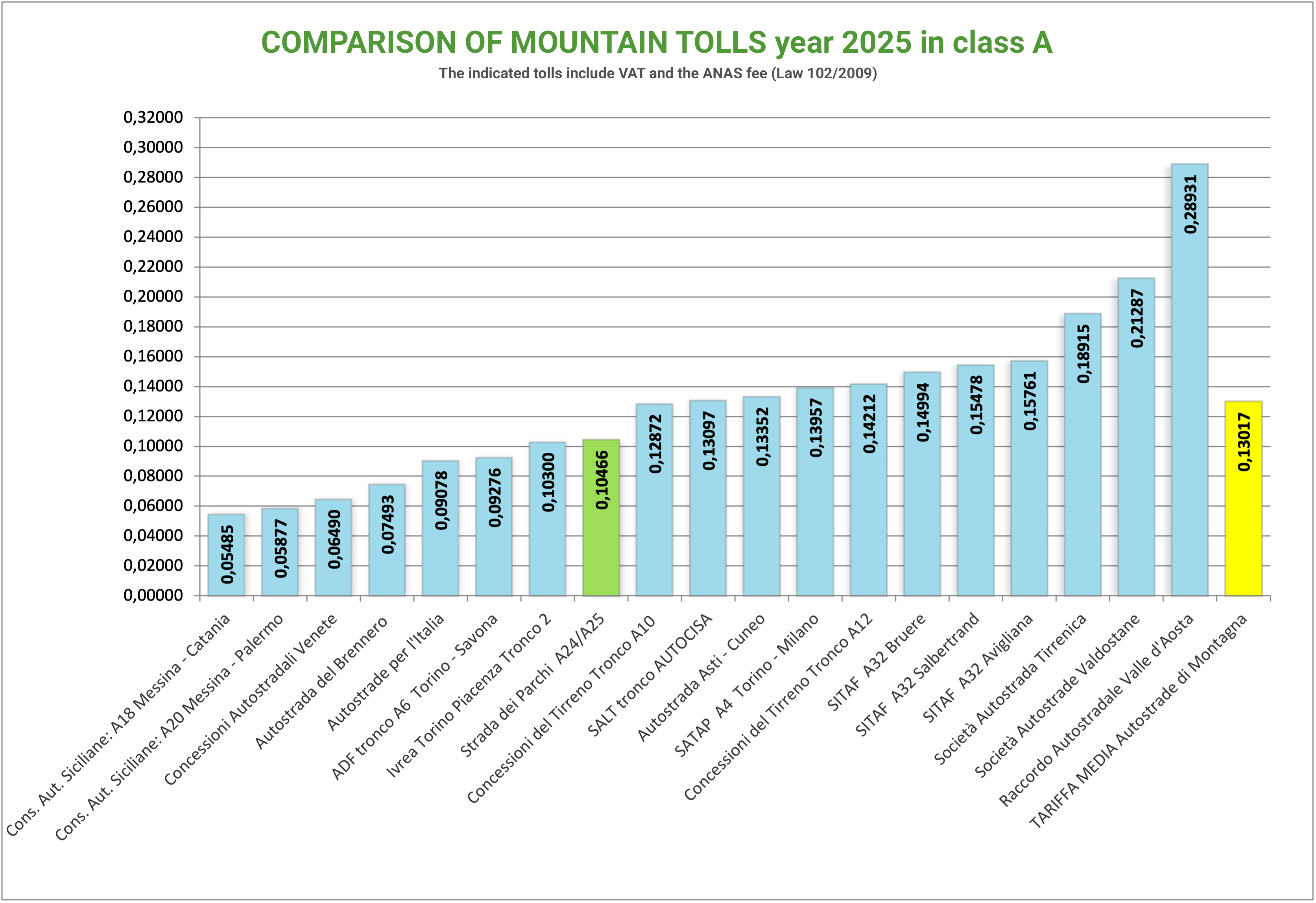
THE RATES
How the toll is calculated
The toll is calculated by multiplying the unit tariff (per kilometer) pertaining to Strada dei Parchi, increased by the amount pertaining to ANAS (as per Law 102/2009), by the kilometers, considering that in addition to the kilometers between tollbooth and tollbooth, the kilometers of the interchanges, the slip roads and the free highway sections before and after the tollbooth, built and managed by the Concessionaire, are counted. VAT (22 percent) should be added to the resulting amount and rounding up or down to the nearest 10 cents should be applied. Rounding is applied automatically without any discretion on the part of Strada dei Parchi and is governed by Interministerial Decree No. 10440/28/133 of 12.XI.2001 of the Ministry of Infrastructure and Transport and the Ministry of Economy and Finance. The unit tariff applied depends on the type of vehicle used (5 classes) and the characteristics of the highway sections driven (flat or mountainous). On some highway sections, defined as having a “semi-closed” system (Lunghezza, Settecamini and Ponte di Nona), the toll is independent of the kilometers traveled; the calculation of the amount to be paid is based on a lump-sum length established with the approval of the Conceding Ministry. These systems differ from the “closed” systems in which the Customer pays the toll corresponding to the route traveled.
Toll payment can be made either by paper ticket or by “electronic” ticket via electronic toll collection apparatus.
Invariance of fares on A24 and A25
In accordance with the law, Strada dei Parchi SpA has been reinstated in the ownership of the concession as of January 1, 2024, providing that the highway tariffs on the network under management will remain firm at the values already established for the year 2017 until the expiration of the concession, thus disapplying the mechanism of the annual increase provided for in the single agreement of 11/18/2009.
URGENT SAFETY WORK
Strada dei Parchi has carried out a major investment plan to upgrade, modernize and upgrade the A24 and A25 highways.
The completion of the Plan was achieved in 2009 for the interventions included in the Convention of 20.12.2001, including the construction of about 6 km of the western carriageway of the A24, between the Basciano and Cartecchio/Teramo interchanges, completed on 28.04.2009 with a total economic commitment of € 130 million.
During 2014, investments related to the Single Convention of November 18, 2009 were completed.
The implementation of the works involved a total financial commitment of more than 1 billion euros.
Following the seismic events that occurred in central Italy, knowing the condition of its Infrastructure, Strada dei Parchi S.p.A. represented to the Ministry of Infrastructure and Transport the need to carry out Urgent Mass In Safety (MISU) interventions.
The interventions are aimed at avoiding that in case of a seismic event, the practicability of the Highway, which is considered by law “strategic for civil protection purposes,” is compromised, as it is the only most efficient way to connect the two coasts of central Italy and therefore the only way to reach inland areas in case of a disastrous natural event as, moreover, happened during the seismic event of both L’Aquila (2009) and Amatrice (2016).
In June 2018, the works for the safety upgrading of the viaduct decks were completed with the aim of preventing a “step” on the road surface in the event of an earthquake at the joints, which is extremely dangerous for travelers; an economic commitment of more than 170 million that committed technical resources and highly specialized workers. Pursuant to Law No. 228 of 24.12.2012 during 2019 began the first seismic upgrading works on the viaducts of the A24 and A25 highways, the operational phases of which imply long-term construction sites that are immovable both during the summer and winter seasons. In the 2019-2023 period, the seismic upgrading works concerned the Popoli viaduct and the viaduct of the two-way ramp of the Bussi interchange on the A25 and the 13 viaducts insisting on the section of the A24 between the Tornimparte and L’Aquila Ovest interchanges, where the worksites involve the activation of traffic detour with vehicles flowing on a single carriageway in two directions.
The following photos illustrate both how the phenomenon occurred at the viaduct joints after the 2009 earthquake event and some highlights of the interventions carried out for the girder and caisson decks.
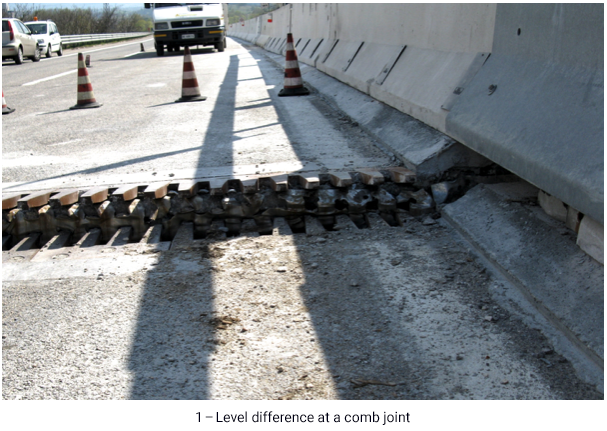
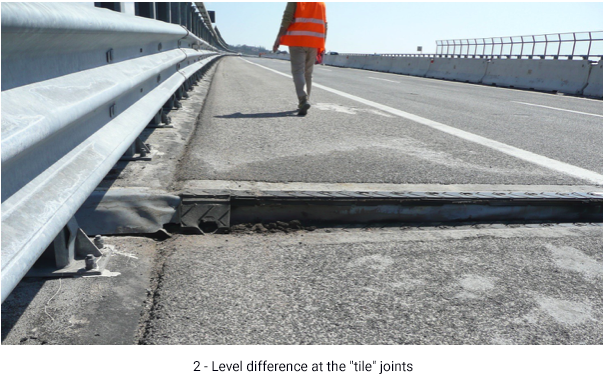
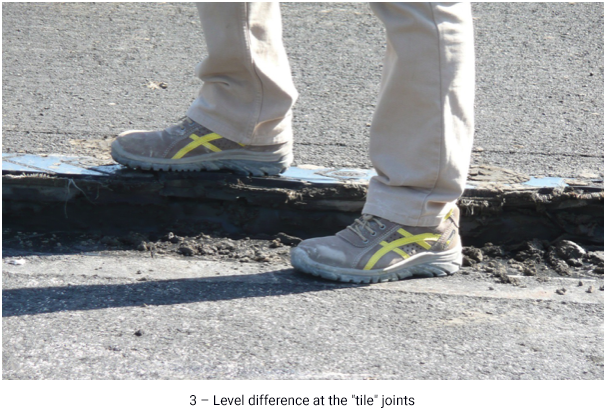
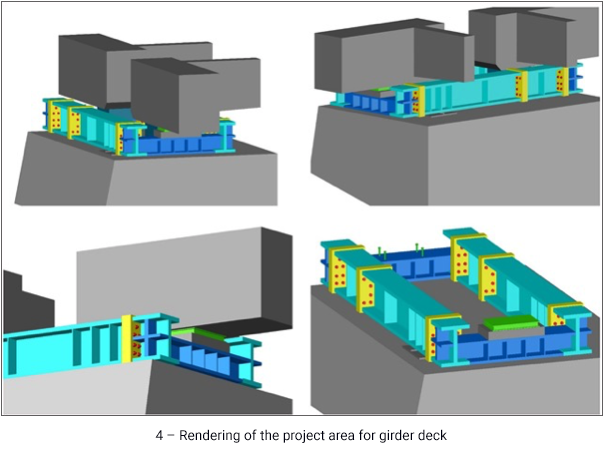
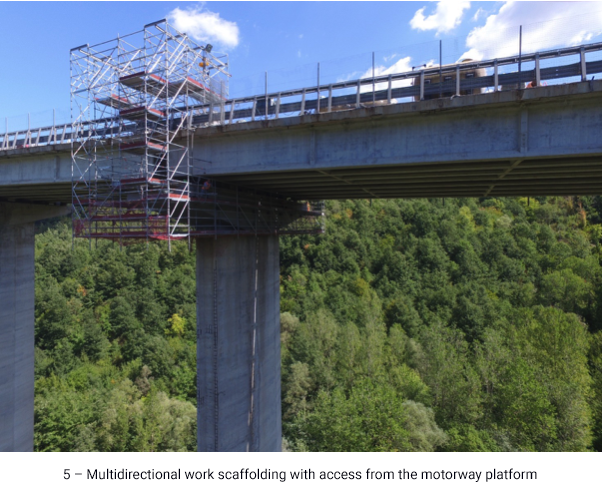
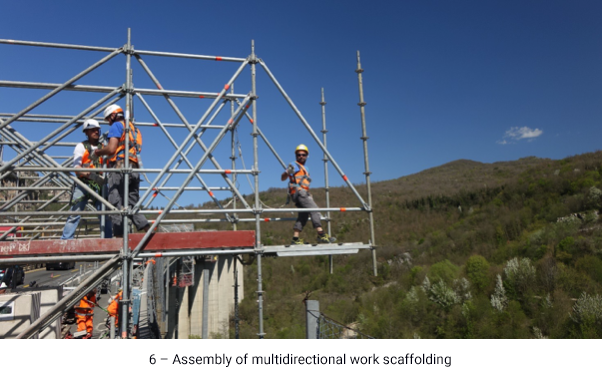
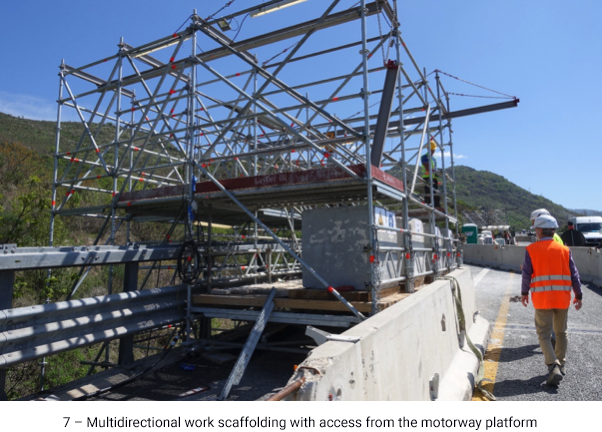

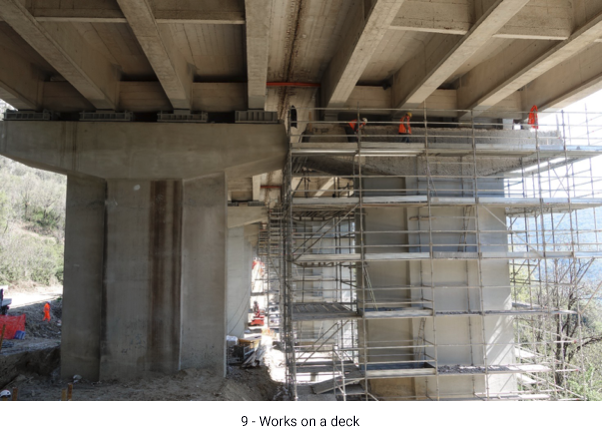
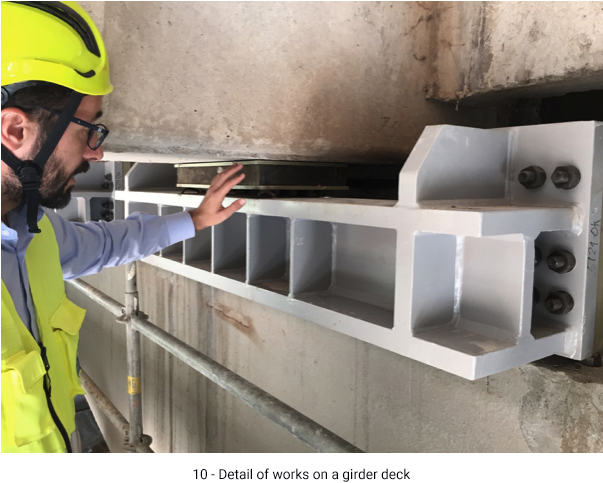
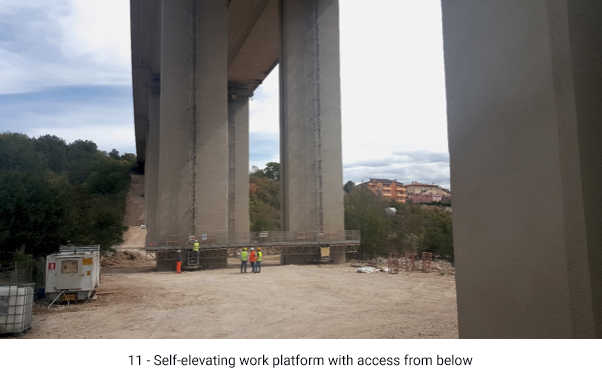
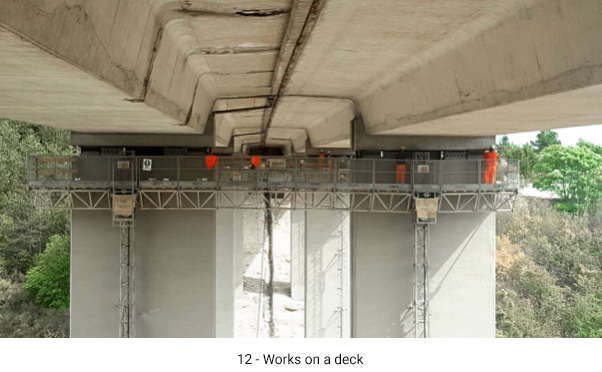
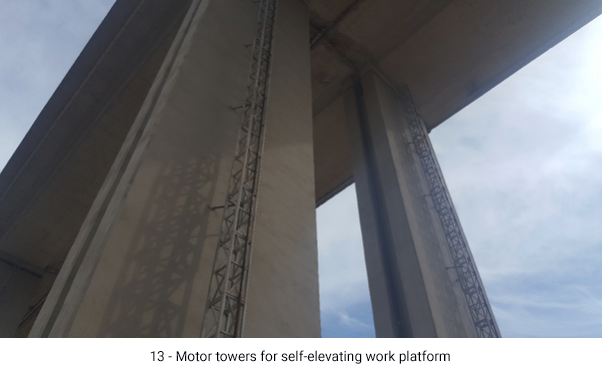
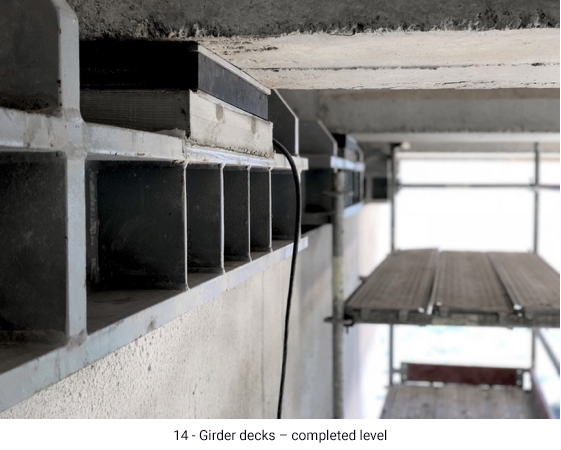
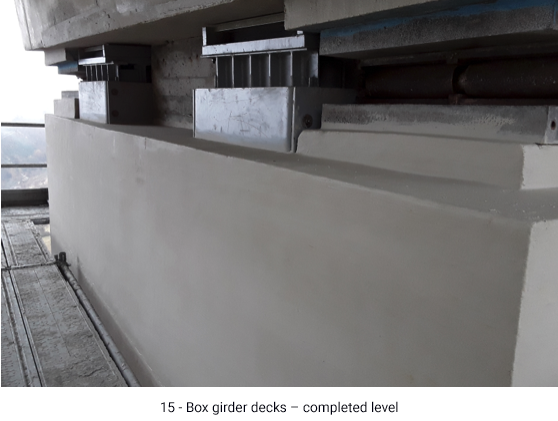
HIGHWAY SAFETY
It bears repeating, the A24 and A25 highways do not present any criticality with regard to the statics of the structures under normal conditions of use (i.e., in the absence of seismic shocks). This is guaranteed by the continuous maintenance done by the Concessionaire as a result of the inspections carried out by highly specialized technical personnel who, on a quarterly basis, monitor the state of preservation of the individual construction elements. In the case of the presence of anomalies deemed significant, in fact, specific studies are carried out accompanied, if necessary, by on-site and/or laboratory investigations as well as static verification calculations, at the outcome of which it is determined whether it is necessary to carry out specific interventions.
The problems, as moreover highlighted during the 2009 earthquakes in L’Aquila and in 2016/2017 in the Amatrice area, arise only in the case of particularly large seismic events that, due to their violence, could damage the structures of the viaducts, which, having been designed and built between the ′60s-′70s are unable to contain the forces generated by such destructive seismic shocks.
The seismic vulnerability assessments carried out on the viaducts, according to the current safety criteria, have shown that it is necessary to intervene quickly to make the works safe, as provided for by art. 1, paragraph 183 of Law no. December 24, 2012. 228 bearing “Provisions for the formation of the annual and multi-year budget of the State (Stability Law 2013)”:
“In consideration of the classification of the A24 and A25 freeways as strategic works for the purposes of civil protection as a result of the Decree of the President of the Council of Ministers of October 21, 2003 and subsequent amendments and the consequent need to proceed to the adaptation of the same to the regulations in force for seismic adaptation and safety of the viaducts on the basis of the contents of the O.P.C.M. 3274 of 2003 and No. 3316 of 2003 and subsequent amendments… OMISSIS “…
Durability is also an important requirement in order not to reduce the performance level of the works over time.
This requirement must take into account the environmental conditions that characterize the A24 and A25 highway network, in particular the alternation of freeze-thaw cycles and the aggressive action of the chlorides contained in the melting salts used in winter operations, which put the materials constituting the existing works of art to a severe test on a daily basis. These same severe environmental conditions together with the material technologies and construction details in use in the 1960s-70s, and taking into account the almost total absence of routine maintenance not performed by the previous Concessionaire for about 30 years (Strada dei parchi took over management on 01/01/2003), have negatively affected the level of durability of the artifacts by widely accelerating their degradation. It should be borne in mind, however, that the future adaptation of the works to current regulations must also involve the acquisition of an adequate level of durability of the same.
INVESTMENTS MADE BY SDP
As they already discuss in the section on tariffs, these are directly related to the investments made by the concessionaire.
During the period of management of Strada dei Parchi, the largest tariff increases were recorded from 2011 to 2014, a period during which the Concessionaire incurred huge investments for the realization of very important works:
-
- Rome’s Complanari, for starters: works that have made getting in and out of the capital safer and faster, totaling 258 million euros (including 170 million euros in grants);
- The doubling of the highway section in the direction of Teramo,
- Viaduct safety interventions,
- The equipping of the Gran Sasso tunnel with new, more modern fire-fighting systems
- the automation of gas stations and the laying of drainage pavement on 100 kilometers of network
- the upgrading work on the entire highway inherited from the old Sara management (about 30 years without maintenance work)
These are all works and investments that Strada dei Parchi has carried out while keeping employment levels intact, without cutting a single job and despite significant operating losses, which have been met with major capital injections from shareholders (to date about 170 million euros) and certainly not with toll increases.
Strada dei Parchi is among the few Concessionaires to have completed all the investments stipulated in the 2009 Agreement, as well as all routine maintenance from 2003 to 2017.
The table below shows the financial monitoring of investments and their progress with reference to the current Agreement, comparing the final figures for 2016 and the entire regulatory period with the corresponding amounts provided for in the Economic and Financial Plan shows that Strada dei Parchi has carried out 104.69% of the investments provided for in the Agreement in the period 2009 – 2016.
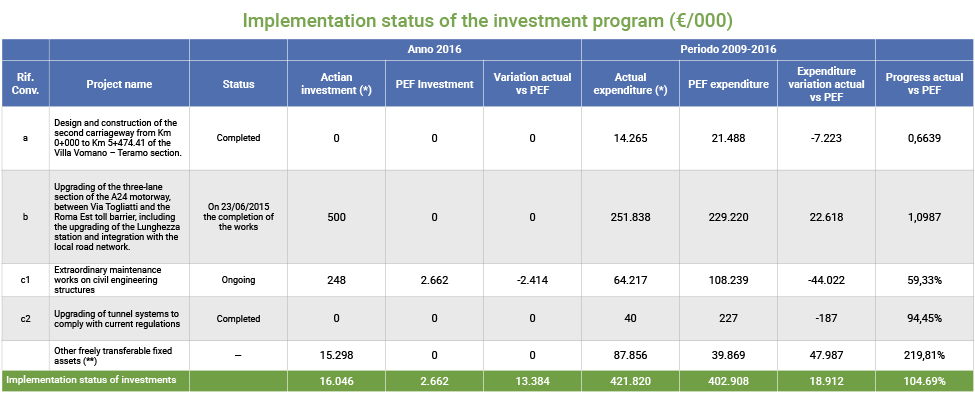
(*) The breakdown of the final figures among the individual investments was made on the basis of cost accounting data to allow for the separation of capitalized costs of individual Works
(**) Residual investments from the Financial Plan of the 2001 Convention and the Single Convention, as well as costs related to consultancy, assistance and drafting of papers for the design of the interventions included in the updated Economic and Financial Plan
On the subject of maintenance works, on the other hand, the table and chart below illustrate the progressive amounts achieved in the regulatory period by the Company and their comparisons with the corresponding forecast values in the Economic and Financial Plan. The chart shows that the Company carried out 105.44% of the maintenance work stipulated in the Agreement during the period 2009 – 2016

THE COMPLANARIES
Coplanar roads are highway in their own right.
Their construction was requested in the first half of 2005 by the Mayor of Rome; in fact, the Tender Agreement provided for the construction of the 3rd lane from the Barriera di Roma Est to the Tangenziale Est, following the request of the Municipality of Rome, the Grantor and the Concessionaire (in agreement with the Municipality) decided to build the Complanari because they were more responsive to traffic needs due to the major urban development that had taken place over the years near the highway route.
The estimated cost of the executive project was € 258.9 ML and realized with the following funding:
- ANAS: 85 M€;
- Local authorities: 85 M€ (Lazio Region and Province of Rome 50 M€; Municipality of Rome 35 M€);
- Parks Road: 88.9 M€.
These works involved not only the Casal Bertone – Svincolo Togliatti section (by 2.5 km), but additional activities related to the entire route goes from Portonaccio to Roma Est (about 15 km).
The final balance of the intervention was found to be exactly in accordance with the approved economic framework and, as far as the execution time is concerned, the work was completed about 1 month ahead of the contractual schedule despite having, in the course of the work, had to resolve numerous unforeseen contingencies including the main ones:
- extensive archaeological finds of significantly greater importance than expected;
- Numerous illegal underground utilities;
- various issues of confrontation with the area to minimize inconvenience to residents in an area marked by heavy squatter urbanization.
In the context of Public Works in Italy over the last two decades, this intervention is probably the only one to have been carried out within the contractual timeframe without overruns compared to the initial economic framework.
THE SERVICE AREAS
The 12 Service Areas currently in operation, on the Strada dei Parchi network, are open 24/7. In accordance with the provisions of the 2001 Convention and the Competition and Market Authority, Strada dei Parchi has sub-concessioned all services (fuel, catering, etc.) in the Areas to specialized Operators, based on competitive, transparent and non-discriminatory procedures.
An investment plan involving the upgrading of Service Areas is underway, resulting from several contracting procedures initiated since 2015 and also recently concluded with several brand changes.
The Agreement, which regulates the relationship between Strada dei Parchi and the Grantor, provides for the construction of two new facilities named Rocca Casale South and North to be located respectively near the progressives km 138.100 and 137.800 of the A25 highway.
In August 2012, competitive bidding procedures were launched to entrust the construction and operation of the new AdSs in question, procedures that did not register any concrete interest from the market; in practice, the bids were unsuccessful.
In February 2016, the procedure for selecting possible operators for the entrustment of said activities was repeated by leveraging a different distribution of tender commitments in order to make the investments to be made more attractive, and still sustainable, achieving the same negative outcome.





